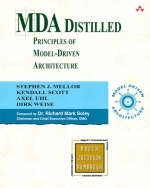
MDA Distilled
Addison Wesley (Verlag)
978-0-201-78891-4 (ISBN)
- Titel ist leider vergriffen;
keine Neuauflage - Artikel merken
"A readable and much needed introduction to MDA."
--Dr. Jim Arlow, coauthor of UML and the Unified Process (Addison-Wesley, 2002) and Enterprise Patterns and MDA (Addison-Wesley, 2004)
"This book provides an excellent introduction to the ideas and technologies that will form the foundation of the model-driven architecture over the coming years. I recommend it wholeheartedly."
--Dr. Andy Evans, Managing Director, Xactium Limited, UK
"Excellent job of distilling MDA down to its core concepts."
--Krzysztof Czarnecki, Univeristy of Waterloo, coauthor of Generative Programming (Addison-Wesley, 2000)
As systems have grown more crucial to the operations of organizations worldwide, so too have the costs associated with building and maintaining them. Enter model-driven architecture (MDA), a standard framework from the Object Management Group (OMG) that allows developers to link object models together to build complete systems. MDA prevents design decisions from being intertwined with the application and keeps it independent of its implementation. The result is an application that can be combined with other technologies as well as other applications, and models that become highly reusable assets.
MDA Distilled is an accessible introduction to the MDA standard and its tools and technologies. The book describes the fundamental features of MDA, how they fit together, and how you can use them in your organization today. You will also learn how to define a model-driven process for a project involving multiple platforms, implement that process, and then test the resulting system.
MDA Distilled will help you understand:
The MDA framework, including the platform-independent model (PIM) and the platform-specific model (PSM)
The Meta Object Facility (MOF)--the OMG's adopted standard for metamodeling
Horizontal, vertical, and merging mappings between models
Building marks and marking models
Elaborating models, including viewing generated models, and managing manual changes
Building executable models with Executable UML
Agile MDA development
Developers and architects can dramatically improve productivity, portability, interoperability, and maintenance with MDA. Find out how with this essential reference, and quickly learn how to harness the significant power of this new framework.
Stephen J. Mellor is cofounder of Project Technology, Inc., a company focused on tools to execute and translate UML models, where he now serves as vice president. He chaired the UML Action Semantics Consortium, and is now active in specifying MDA. In his copious spare time, he is a member of the IEEE Software Industrial Advisory Board. Kendall Scott is a UML trainer and consultant. With more than sixteen years of experience as a technical writer, he is skilled in converting complex, technical material into understandable and easy-to-use manuals. Axel Uhl is a software architect at Interactive Object Software in Germany, where he serves on the team that is developing the MDA tool ArcStyler. Dirk Weise works as a software engineer and consultant in the area of distributed-object computing, model-driven software development, and software architectures. Having been with Interactive Objects Software for several years, he has taken part in developing MDA ArcStyler and has made use of it in several projects.
List of Figures.
Foreword.
Preface.
Organization of This Book.
Frequently Asked Questions.
Acknowledgments.
1. Introduction.
Raising the Level of Abstraction.
Raising the Level of Reuse.
Design-Time Interoperability.
Models as Assets.
2. MDA Terms and Concepts.
Models.
Metamodels and Platforms.
Mapping Between Models.
Marking Models.
Building Languages.
Model Elaboration.
Executable Models.
Agile MDA.
Building an MDA Process.
Executing an MDA Process.
3. Building Models.
Why Model?
Abstraction, Classification, and Generalization.
Subject Matter and Language Abstraction.
Model Projections.
Models and Platforms.
Using Models.
4. Building Metamodels.
Why Metamodels?
Metamodels.
The Four-Layer Architecture.
MOF: A Standard For Metamodeling.
Using Metamodels.
5. Building Mappings.
Why Mappings?
An Informal Example.
Mapping Functions.
Query, Views, and Transformations (QVT).
Scenarios for Mappings.
Merging Mappings for Weaving.
Using Mappings.
6. Building Marking Models.
Why Marks?
Marks and Marking Models.
Applying Marks and Marking Models.
Relating Marks and Model Elements.
Other Marks.
Mark and Marking Model Implementations.
The Theory of Marking Models.
Using Marks.
7. Building Languages.
Why Build a Language?
Who Defines a Language?
WhatÕs In a Language?
Building a Language Using MOF.
Building a Language Using Profiles.
Building Graphical Notations.
Using Languages That YouÕve Built.
8. Elaborating Models.
Why Elaborate Models?
Managing Manual Changes to Generated Models.
Reversibility of Mappings.
Incorporating Legacy Code.
Using Elaboration.
9. Building Executable Models.
Why Executable Models?
Executable UML.
The Execution Model.
Translating Models.
Model Compilers.
Using Executable UML.
10. Agile MDA.
Why Agile MDA?
Agile Methods.
Models, Models, Models.
Design-Time Interoperability Revisited.
Using Agile MDA.
11. Building an MDA Process.
Why Build an MDA Process?
How to Approach the Problem.
Charting the MDA Process.
Identifying Models.
Identifying the Metamodels and Marking Models.
The Long and the Short of Mapping Chains.
Constraint Propagation and Verification.
Using an MDA Process.
12. Executing an MDA Process.
Formalizing Knowledge.
Building Bridges.
An Example Model-Driven Process.
Iterating the Process.
Testing the System.
Executing an MDA Process.
13. The Future of MDA.
Why Not MDA?
The Importance of Standards.
Building a Tool Chain.
Working with Models-as-Assets.
Beyond UML.
Back from the Future.
Glossary.
Bibliography.
Index.
| Erscheint lt. Verlag | 18.3.2004 |
|---|---|
| Reihe/Serie | The Addison-Wesley Object Technology Series |
| Verlagsort | Boston |
| Sprache | englisch |
| Maße | 186 x 234 mm |
| Gewicht | 370 g |
| Themenwelt | Informatik ► Software Entwicklung ► Objektorientierung |
| ISBN-10 | 0-201-78891-8 / 0201788918 |
| ISBN-13 | 978-0-201-78891-4 / 9780201788914 |
| Zustand | Neuware |
| Haben Sie eine Frage zum Produkt? |
aus dem Bereich


